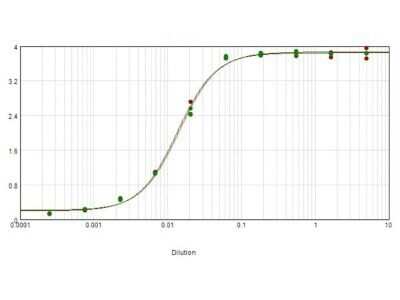Donkey anti-Sheep IgG (H+L) Secondary Antibody [HRP] (Pre-adsorbed)
Novus Biologicals, part of Bio-Techne | Catalog # NBP1-73720


Forumulation
Catalog #
Key Product Details
Species Reactivity
Sheep
Applications
ELISA, Immunohistochemistry, Western Blot
Label
HRP
Antibody Source
Polyclonal Donkey IgG
Format
Pre-adsorbed
Concentration
LYOPH mg/ml
Product Specifications
Immunogen
Donkey anti-Sheep IgG (H+L) Secondary Antibody [HRP] (Pre-adsorbed) was produced by repeated immunization with Sheep IgG whole molecule in donkey.
Specificity
This antibody was pre-adsorbed against Chicken, Guinea Pig, Hamster, Horse, Human, Mouse, Rabbit, and Rat Serum Proteins. No reaction was observed against Chicken, Guinea Pig, Hamster, Horse, Human, Mouse, Rabbit and Rat Serum Proteins.
Clonality
Polyclonal
Host
Donkey
Isotype
IgG
Description
Store vial at 4C prior to restoration. For extended storage aliquot contents and freeze at -20C or below. Avoid cycles of freezing and thawing. Centrifuge product if not completely clear after standing at room temperature. This product is stable for several weeks at 4C as an undiluted liquid. Dilute only prior to immediate use.
This product was prepared from monospecific antiserum by immunoaffinity chromatography using Sheep IgG coupled to agarose beads followed by solid phase adsorption(s) to remove any unwanted reactivities. Assay by immunoelectrophoresis resulted in a single precipitin arc against anti-Peroxidase, anti-Donkey Serum, Sheep IgG and Sheep Serum
This product was prepared from monospecific antiserum by immunoaffinity chromatography using Sheep IgG coupled to agarose beads followed by solid phase adsorption(s) to remove any unwanted reactivities. Assay by immunoelectrophoresis resulted in a single precipitin arc against anti-Peroxidase, anti-Donkey Serum, Sheep IgG and Sheep Serum
Scientific Data Images for Donkey anti-Sheep IgG (H+L) Secondary Antibody [HRP] (Pre-adsorbed)
ELISA: Donkey anti-Sheep IgG (H+L) Secondary Antibody [HRP] (Pre-adsorbed) [NBP1-73720] - ELISA results of purified Donkey anti-Sheep IgG (H+L) Secondary Antibody [HRP] (Pre-adsorbed) tested against purified Sheep IgG. Each well was coated in duplicate with 1.0 ug of Sheep IgG (green line). The starting dilution of antibody was 5ug/ml and the X-axis represents the Log10 of a 3-fold dilution. This titration is a 4-parameter curve fit where the IC50 is defined as the titer of the antibody. Assay performed using TMB substrate.
Applications for Donkey anti-Sheep IgG (H+L) Secondary Antibody [HRP] (Pre-adsorbed)
Application
Recommended Usage
ELISA
1:65000
Immunohistochemistry
1:500 - 1:2500
Western Blot
1:1000 - 1:10000
Application Notes
This product has been tested by ELISA and is suitable for immunoblotting (western or dot blot), ELISA, immunoperoxidase electron microscopy and immunohistochemistry as well as other peroxidase-antibody based enzymatic assays requiring lot-to-lot consistency.
NOTE: Do NOT add Sodium Azide (it inhibits HRP irreversibly).
NOTE: Do NOT add Sodium Azide (it inhibits HRP irreversibly).
Formulation, Preparation, and Storage
Purification
Multi-step
Reconstitution
Reconstitute with 1.0 ml deionized water (or equivalent).
Formulation
Lyophilized from 0.02 M Potassium Phosphate, 0.15 M Sodium Chloride, pH 7.2, 10 mg/mL Bovine Serum Albumin (BSA) - Immunoglobulin and Protease free
Format
Pre-adsorbed
Preservative
0.01% Gentamicin Sulfate
Concentration
LYOPH mg/ml
Shipping
The product is shipped with polar packs. Upon receipt, store it immediately at the temperature recommended below.
Stability & Storage
Store lyophilized antibody at 4C in the dark. Aliquot reconstituted liquid and store at -20C. Avoid freeze-thaw cycles.
Background: IgG (H+L)
The 4 IgG subclasses, sharing 95% amino acid identity, include IgG1, IgG2, IgG3, and IgG4 for humans and IgG1, IgG2a, IgG2b, and IgG3 for mice. The relative abundance of each human subclass is 60% for IgG1, 32% for IgG2, 4% for IgG3, and 4% for IgG4. In an IgG deficiency, there may be a shortage of one or more subclasses (4).
References
1. Painter RH. (1998) Encyclopedia of Immunology (Second Edition). Elsevier. 1208-1211
2. Chapter 9 - Antibodies. (2012) Immunology for Pharmacy. Mosby 70-78
3. Schroeder H, Cavacini, L. (2010) Structure and Function of Immunoglobulins. J Allergy Clin Immunol. 125(2 0 2): S41-S52. PMID: 20176268
4. Vidarsson G, Dekkers G, Rispens T. (2014) IgG subclasses and allotypes: from structure to effector functions. Front Immunol. 5:520. PMID: 25368619
Additional IgG (H+L) Products
Product Documents for Donkey anti-Sheep IgG (H+L) Secondary Antibody [HRP] (Pre-adsorbed)
Product Specific Notices for Donkey anti-Sheep IgG (H+L) Secondary Antibody [HRP] (Pre-adsorbed)
This product is for research use only and is not approved for use in humans or in clinical diagnosis. Secondary Antibodies are guaranteed for 1 year from date of receipt.
